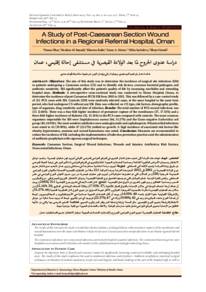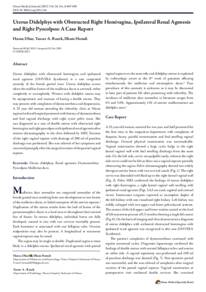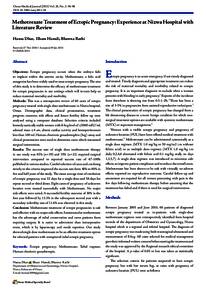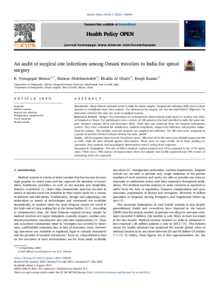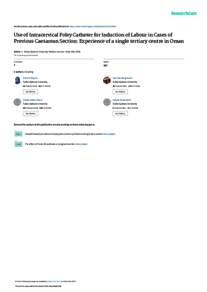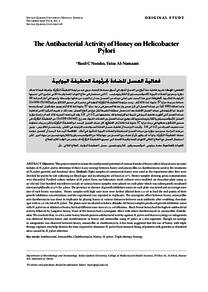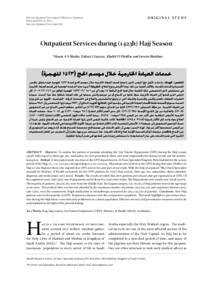Document
A Study of post-caesarean section wound infections in a regional referral hospital, Oman.
Contributors
Other titles
دراسة عدوى الجروح لما بعد الولادة القيصرية في مستشفى إحالة إقليمي، عمان
Publisher
College of Medicine, Sultan Qaboos University.
Gregorian
2014-05
Language
English
Subject
English abstract
Objectives: The aim of this study was to determine the incidence of surgical site infections (SSI)
in patients undergoing a Caesarean section (CS) and to identify risk factors, common bacterial pathogens and
antibiotic sensitivity. SSI significantly affect the patient's quality of life by increasing morbidity and extending
hospital stays. Methods: A retrospective cross-sectional study was conducted in Nizwa Hospital, Oman, to
determine the incidence of post-Caesarean (PCS) SSI from 2001 to 2012. This was followed by a case-control study
of 211 PCS cases with SSI. Controls (220) were randomly selected cases, at the same hospital in the same time
period, who had undergone CS without any SSI. Data was collected on CS type, risk factors, demographic profile,
type of organism, drug sensitivity and date of infection. Results: The total number of PCS wound infections was
211 (2.66%). There was a four-fold higher incidence of premature rupture of the membranes (37, 17.53%) and a
three-fold higher incidence of diabetes (32, 15.16%) in the PCS cases compared with controls. The most common
organisms responsible for SSI were Staphylococcus aureus (66, 31.27%) and the Gram-negative Escherichia coli
group (40, 18.95%). The most sensitive antibiotics were aminoglycoside and cephalosporin. Polymicrobial infections
were noted in 42 (19.90%), while 47 (22.27%) yielded no growth. A high incidence of associated risk factors like
obesity, hypertension, anaemia and wound haematoma was noted. Conclusion: Measures are recommended to
reduce the incidence of SSI, including the implementation of infection prevention practices and the administration
of antibiotic prophylaxis with rigorous surgical techniques.
Sponsorship
Sultan Qaboos University.
Member of
Resource URL
Citation
Dhar, Hansa, Al-Busaidi, Ibrahim, Rathi, Bhawna, Nimre, Eman A., Sachdeva, Vibha, & Hamdi, Ilham (2014). A Study of Post-Caesarean Section Wound Infections in a Regional Referral Hospital, Oman. Sultan Qaboos Medical Journal, 14 (2), 211-217.
Arabic abstract
الملخص: الهدف: تهدف هذه الدراسة إلى تحديد معدل انتشار العدوى في الموقع الجراحي للمرضى اللواتي أجريت لهن عمليات قيصرية، وتحديد عوامل الاختطار ومسببات الأمراض البكتيرية الشائعة وحساسية المضادات الحيوية. انتشار العدوى في الموقع الجراحي له تأثير كبير على نوعية الحياة للمرضى عن طريق زيادة المراضة وتمديد الإقامة في المستشفى. الطريقة: أجريت دراسة استعادية مستعرضة في مستشفى نزوى، عمان، لتحديد مدى انتشار عدوی جرح الولادة القيصرية من 2001 إلى 2012. أتبعت هذة الدراسة بدراسة لمراقبة 211 حالة من العمليات القيصرية المصابة بالتهاب الجرح الجراحي. المجموعة المرجعية (220) من الحالات التي تم اختيارها عشوائيا لمن أجريت لهن عمليات قيصرية من دون حدوث التهاب الجرح الجراحي في نفس المستشفى ولنفس الفترة الزمنية. شملت البيانات التي تم جمعها تفاصيل نوع العملية القيصرية، وعوامل الاختطار، التوزيع الديموغرافي ، نوع الميكروب المسبب وحساسية العقاقير و يوم ظهور العدوى من تاريخ عمل القيصرية. النتائج: كان العدد الإجمالي لعدوى جرح القيصرية 211 (%2.66). ووجد أن هناك أربعة أضعاف الزيادة في حالات الإصابة بالتمزق المبكر للأغشية (37، %17.53 ) وثلاثة أضعاف الزيادة في السكري (32، %15.16) من حالات بعد العمليات القيصرية مقارنة بالمجموعة المرجعية. الميكروب الأكثر شيوعا المسؤول عن عدوى الجرح كان العنقودية الذهبية (66، %31.27) والإشريكيّة القولونية سلبية الغرام (عدد= 40، %18.95). ووجد أن أكثر المضادات الحيوية حساسية هي الأمينوغليكوزيد و السيفالوسبورين. لوحظ أن إصابة الجرح متعدد الميكروبات وجد في 42 (%19.90 ) وأنه في 47 (%22.27) لم يوجد أي نمو بكتيري. لوحظ أنه يوجد نسبة عالية من عوامل الاختطار المرتبطة بعدوى الجرح القيصري مثل السمنة وارتفاع ضغط الدم وفقر الدم والورم الدموي. الخلاصة: التدابير الموصى بها والتي من شأنها التقليل من الإصابة بعدوى الموقع الجراحي تشمل تنفيذ ممارسات الوقاية والاتقاء بالمضادات الحيوية مع تقنية جراحية جيدة.
Category
Journal articles

